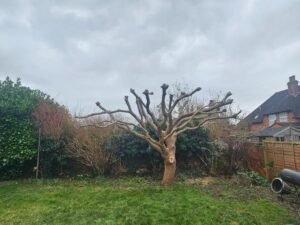Essential Tips by Tiptop Tree and Groundcare
Winter is here, and with it comes a prime opportunity to give your trees the care they deserve. At TipTop Tree and Groundcare Services, we’re passionate about keeping the trees in Didcot and surrounding areas healthy, safe, and stunning year-round. One of the best practices for winter tree care? Pollarding—a technique steeped in tradition and proven to deliver lasting benefits.
Let’s explore why pollarding is essential for tree health and how our local expertise can make all the difference.
What is Tree Pollarding?
Tree pollarding is a pruning method where branches are cut back to a specific point, encouraging controlled, fresh growth in the spring. This technique has been used since medieval times, especially in urban settings, to manage tree size, ensure safety, and improve aesthetics.
At Tiptop Tree and Groundcare, we practise careful, strategic pollarding to ensure your trees not only look good but also remain robust and disease-free.
Why Choose Pollarding This Winter?
Winter is the perfect season for pollarding because most trees are dormant, minimising stress and the risk of infections. Here’s why you should consider pollarding this season:
- Healthier Growth
Removing damaged or weak branches encourages vigorous new growth in the spring while preventing decay and disease from spreading. - Enhanced Safety
Overgrown branches are vulnerable to winter winds and storms, increasing the risk of falling limbs. Pollarding eliminates these hazards. - Space and Sunlight Management
Keep your trees neat and prevent them from obstructing sunlight or growing too close to structures. - Longevity
Regular pollarding increases a tree’s lifespan by maintaining its structural integrity and vitality.
Expert Advice from TipTop Tree and Groundcare
Did you know? Pollarding has been historically used not just for tree management but also for resource harvesting, including firewood and fodder, as far back as Roman times.
Here’s our advice to make the most of pollarding:
- Best Timing: Winter, when the tree is dormant, ensures quicker recovery.
- Frequency: Every 2-5 years, depending on the tree species.
- Tree Suitability: Not all trees are ideal candidates. Species like lime, plane, and willow respond particularly well.
Frequently Asked Questions
Q: Will pollarding make my tree look bare?
A: Initially, yes. But come spring, you’ll enjoy vibrant, lush regrowth.
Q: Is pollarding safe for large trees?
A: Absolutely. With the right expertise and equipment—like ours—large trees can be pollarded safely.
Q: What makes TipTop Tree and Groundcare unique?
A: As a local company in Didcot, we bring unmatched knowledge of the area’s trees and environment. Our team is highly trained, insured, and committed to exceptional service.
Why Choose Local Experts for Pollarding?
Trees in Didcot face unique challenges, from urban space constraints in London to the specific soil types in Oxfordshire. Our familiarity with these local factors allows us to provide personalised, effective tree care that national chains simply cannot.
When you work with TipTop Tree and Groundcare, you’re choosing a team that values the natural beauty of our community and prioritises sustainable, eco-friendly practices.
Let’s Care for Your Trees Together
Winter is the ideal time to prioritise your tree care. Pollarding not only safeguards your trees but also ensures they’re ready to thrive come spring.
Connect with Us!
Stay updated with our latest projects and tips on Facebook!
📞 Call us today for a free tree assessment: 07392001837
🌐 Visit our website: https://tiptoptreeandgroundcare.co.uk
At Tiptop Tree and Groundcare, we’re here to help you make your trees a stunning, healthy feature of your property—no matter the season.
References




